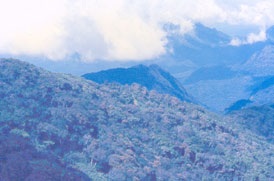Montane sub tropical forests
Broad-leaved forests
Broad-leaved forests are found in the Eastern Himalayas and the Western Ghats, along the Silent Valley. There is a marked difference in the form of the vegetation in the two areas. In the Silent Valley, the poonspar, cinnamon, rhododendron, and fragrant grass are predominant. In the Eastern Himalayas, the flora has been badly affected by the shifting cultivation and forest fires. These wet forests consist mainly of evergreen trees with a sprinkling of deciduous here and there. There are oak, alder, chestnut, birch, and cherry trees. There are a large variety of orchids, bamboo and creepers.
Pine
Pine forests are found in the steep dry slopes of the Shivalik Hills, Western and Central Himalayas, Khasi, Naga, and Manipur Hills. The trees predominantly found in these areas are the chir, oak, rhododendron, and pine. In the lower regions sal, sandan, amla, and laburnum are found.
Dry evergreen
Dry evergreen forests normally have a prolonged hot and dry season and a cold winter. It generally has evergreen trees with shining leaves that have a varnished look. Some of the more common ones are the pomegranate, olive, and oleander. These forests are found in the Shivalik Hills and foothills of the Himalayas up to a height of 1000 metres.
Montane temperate forests
Wet
Wet montane temperate forests occur in the North and the South. In the North, it is found in the region to the east of Nepal into Arunachal Pradesh, at a height of 1800–3000 metres, receiving a minimum rainfall of 2000 mm. In the South, it is found in parts of the Niligiri Hills, the higher reaches of Kerala. The forests in the northern region are denser than in the South. This is because over time the original trees have been replaced by fast-growing varieties such as the eucalyptus. Rhododendrons and a variety of ground flora can be found here.
In the North, there are three layers of forests: the higher layer has mainly coniferous, the middle layer has deciduous trees such as the oak and the lowest layer is covered by rhododendron and champa.
Moist
This type spreads from the Western Himalayas to the Eastern Himalayas. The trees found in the western section are broad-leaved oak, brown oak, walnut, rhododendron, etc. In the Eastern Himalayas, the rainfall is much heavier and therefore the vegetation is also more lush and dense. There are a large variety of broad-leaved trees, ferns, and bamboo. Coniferous trees are also found here, some of the varieties being different from the ones found in the South.
Dry
This type is found mainly in Lahul, Kinnaur, Sikkim, and other parts of the Himalayas. There are predominantly coniferous trees that are not too tall, along with broad-leaved trees such as the oak, maple, and ash. At higher elevation, fir, juniper, deodar, and chilgoza can be found.
Sub alpine
Sub alpine forests extends from Kashmir to Arunachal Pradesh between 2900 to 3500 metres. In the Western Himalayas, the vegetation consists mainly of juniper, rhododendron, willow, and black currant. In the eastern parts, red fir, black juniper, birch, and larch are the common trees. Due to heavy rainfall and high humidity the timberline in this part is higher than that in the West. Rhododendron of many species covers the hills in these parts.
Alpine
Moist
Moist alpines are found all along the Himalayas and on the higher hills near the Myanmar border. It has a low scrub, dense evergreen forest, consisting mainly of rhododendron and birch. Mosses and ferns cover the ground in patches. This region receives heavy snowfall.
Dry
Dry alpines are found from about 3000 metres to about 4900 metres. Dwarf plants predominate, mainly the black juniper, the drooping juniper, honeysuckle, and willow.



 The broad class of tropical montane forests are found in the American, African and Asian continents. Plants are adapted to low temperature and high radiation levels.
The broad class of tropical montane forests are found in the American, African and Asian continents. Plants are adapted to low temperature and high radiation levels. National Park and Silent Valley National Park. The biodiversity hotspot,
National Park and Silent Valley National Park. The biodiversity hotspot,  plzz...
plzz...